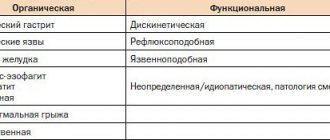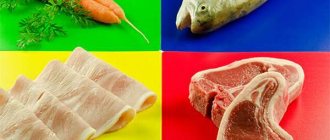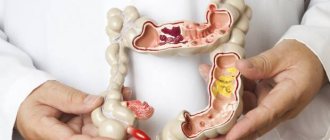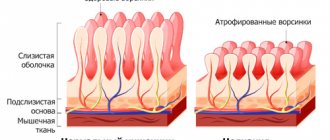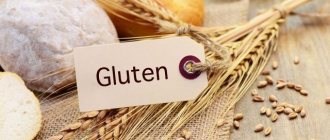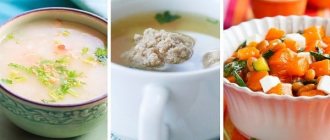A large number of people suffer from such an unpleasant disease as constipation. In addition to constant discomfort, this delicate disease contributes to the formation of toxins, and, consequently, to the slow poisoning of the body.
Intoxication with waste products that are not eliminated from the body in a timely manner is manifested by headaches, nausea, heartburn and abdominal pain, and increased gas formation.
When treating chronic constipation, medications are not prescribed; they are usually ineffective at this stage of the disease. Treatment is carried out by prescribing a special therapeutic diet, which is the most effective method of curing this disease.
Recommended table foods 3, diets for gastrointestinal activity
Therapeutic diet 3 in your diet should contain the following types of products:
- Dietary bread (bran, black, with natural additives - seeds, caraway seeds, herbs). Daily norm – 200-250g;
- Soups, preferably vegetarian, since rich meat or fish broths contribute to weak intestinal motility. First courses are eaten once a day.
- Lean meat: beef, rabbit, skinless poultry. Meat dishes are best steamed, boiled or baked in large pieces. Meat is eaten once a day;
- Low-fat fish, also mostly boiled or baked whole carcasses or large pieces. Eat fish once a day (instead of meat);
- Vegetables can be eaten without restrictions. In the diet menu 3 they are present both raw and boiled (side dishes for meat and fish). Allowed: carrots, tomatoes, cucumbers, beets, pumpkin, zucchini, cauliflower. Potatoes can only be consumed baked, without skin;
- Fruits and berries are eaten twice a day. You can eat apples, cherries, cherries, apricots, plums, bananas, kiwis, grapes, strawberries, wild strawberries, raspberries, blackberries;
- Among sweets, table 3 of the diet for constipation recommends, first of all, honey - it has a mild laxative effect. It is also good to eat prunes, dried apricots, jams and various fruit jellies;
- Dairy products – kefir, cottage cheese, low-fat milk;
- Among the cereals in diet 3, preference should be given to buckwheat, millet, barley and wheat. They are used to prepare crumbly porridges or casseroles;
- Vegetable oils (as a salad dressing);
- Hard cheeses;
- Tea from fragrant herbs, freshly squeezed juices.
Diet at different stages
Constipation can occur in different ways; the diet is selected individually, based on the stage of the disease, the cause that caused it, and the patient’s capabilities.
For spastic constipation
Sometimes intestinal spasm is a response to irritation of the central nervous system, the entry of bacteria or poorly digested food into the intestinal lumen.
Proper nutrition for constipation
Spastic constipation manifests itself with the following symptoms::
- bloating;
- severe pain spread along the intestines;
- constipation;
- defecation in small, solid portions.
With this type of constipation, it is necessary to enrich the diet with foods such as:
- boiled fish and lean meat;
- Uzvar from apples or plums;
- fermented milk products with bifidobacteria;
- boiled or stewed vegetables;
- low-fat chicken broths.
As for medications, you can use antispasmodic drugs such as “No-shpa”.
To prevent intestinal spasms, avoid stressful situations in every possible way and do not lead an inactive lifestyle.
For atonic constipation
Atonic constipation is more often observed in pregnant women and the elderly. The reason for this is wear and tear or functional failures in the nervous and muscular systems of the intestines.
Foods for constipation
To treat atonic constipation using diet, use the following foods :
- fruits containing a lot of fiber (bananas, oranges, persimmons, apricots).
- vegetables rich in fiber (zucchini, carrots, beets, cabbage);
- black bread with bran.
The diet can be very varied; the main task for atonic constipation is not to load the intestines with large amounts of food. It is necessary to take a lot of foods containing fiber, but in small portions.
For chronic constipation
If a patient suffers from chronic constipation, he needs to check his gastrointestinal tract for the presence of organic damage. There is such a disease as “irritable bowel syndrome”; chronic constipation very often develops in it, resulting from poor diet or constant mental overload.
Key foods to include in your diet for chronic constipation:
- porridge (oatmeal, buckwheat);
- black bread with bran;
- dried fruits (dried apricots, prunes, figs);
- curdled milk or kefir;
- fresh vegetable salads;
- fish and lean meat.
How to eat when constipated
With chronic constipation, it is important not only to follow a diet, but also a regimen; sometimes you need to unload emotionally, change your type of activity or lifestyle.
Prohibited foods on diet 3
- Products made from any dough, white bread;
- Canned food, marinades, smoked meats;
- Fatty meat and fish;
- By-products;
- Radish, radish – vegetables that cause flatulence;
- Vermicelli;
- Hard-boiled eggs;
- Onion and garlic;
- Mushrooms;
- Cocoa and chocolate;
- Strong tea and coffee;
- Alcohol.
Diet 3 should be eaten 4-5 times a day. You need to drink a lot of clean water - up to 2-2.5 liters per day. A necessary aid to the diet will be walking for 1.5-2 hours a day or active gymnastics (jumping, bending, swinging legs).
Children's menu
The diet is no different. Is it just that diet menu number 3 for children with constipation is compiled based on the patient’s age. It is important not to forget that the digestive system of babies is still developing, and serious stress can be harmful.
Dishes for kids:
- baked pancakes made from pumpkin or carrots;
- dairy products for children;
- steam souffles or casseroles;
- dried fruits soaked in kefir or cottage cheese.
Children after one year can be given salads with the addition of softened fruits, as well as dishes cooked in the oven.
It is recommended to give meat no more often than 1 r. during the week. Boil or bake fish.
Example diet menu 3 for one day
The Diet 3 menu is very varied. You can prepare various dishes, but try to have raw vegetables on the menu at least 2 times a day during diet 3 - they are suppliers of invaluable fiber, without which the healing process is impossible.
One-day diet menu 3:
Breakfast: carrots grated with apple, buckwheat porridge, herbal tea;
Breakfast 2: seasonal fruits;
Lunch: lean cabbage soup, boiled beet salad with prunes, boiled meat or fish;
Afternoon snack: raw peeled carrots, apple;
Dinner: vegetable stew, fruit salad, herbal tea;
Before going to bed, it is advisable to drink a glass of kefir.
Diet for pregnant women
Diet for pregnant women with constipation
Intestinal atony in pregnant women is a physiological process that is protective for the fetus. The uterus and intestines fit very tightly to each other, increased intestinal motility can provoke the uterus to contract and can lead to premature birth.
Constipation for pregnant women is extremely dangerous; during constipation, many products of protein decay (indole, skatole) are released into the body, they negatively affect the health of the mother and fetus.
The diet of the expectant mother must be enriched with the following products:
- fruits (bananas, figs, plums, apples, apricots, oranges);
- vegetables (potatoes, carrots, cabbage, zucchini);
- Uzvar and dried fruits;
- dairy products, but not more than 600 ml of milk in one day.
All food should be lightly seasoned and low-fat. It is better to give preference to baked and boiled foods.
Diet 3 for children
Diet 3 for children is not fundamentally different from the general diet 3 for adults. The only difference is in the preparation of the dishes, and this depends on the age of the baby. For children from 1.5 to 3 years old, more baked vegetable dishes should be included in the menu, since at such a tender age it is difficult for them to eat raw vegetables. These little ones will happily enjoy baked carrot or pumpkin (not fried!) pancakes, various steamed soufflés and casseroles. It is good to give children dried fruit compote, softened prunes with cottage cheese, kefir and yoghurt.
For older children, you can offer a variety of fruit and vegetable salads, baked pumpkin with honey, baked omelet, and zucchini casserole. With diet 3 for children, it is better to give meat once a week, on other days – low-fat boiled or baked fish.
Features of constipation
Patients often face problems due to poor nutrition. Pathological changes developing in the colon disrupt the mechanism of its emptying. This is how constipation begins. The cause may be poor nutrition or a serious illness.
Diet number 3 for constipation in children and adults plays a big role. If feces are constantly retained in the intestines, it will stretch. The receptors will lose their sensitivity. Violations will cause the development of more serious pathologies in the digestive tract.
Diet number 3 for constipation in adults - weekly menu. General rules
A therapeutic diet is prescribed for diseases and serves specific purposes.
For chronic intestinal diseases (without exacerbation or fading exacerbation) with a predominance of constipation, Table No. 3, Diet No. 3 according to Pevzner, which allows you to normalize impaired intestinal functions, is indicated. This is a physiologically complete diet with a predominance of dietary fiber and magnesium, the sources of which are vegetables, fresh fruits, dried fruits, cereals, and fermented milk drinks. The diet includes cold first courses, sweet dishes and carbonated drinks. At the same time, products that increase fermentation and rotting (fried foods), irritate the mucous membrane and stimulate the secretion of the stomach and pancreas (hot spices, horseradish, mustard, etc.) are excluded. Moderate mechanical stimulation and chemical sparing are provided.
Food is prepared mainly in uncut form, boiled in water or baked. Vegetables are recommended raw and boiled. Eating 4-6 times a day. It is important to maintain a drinking regime - 1.5 liters of free fluid per day. This is explained by the fact that the walls of the rectum, with a lack of fluid, begin to absorb water from the stool, they become hard and difficult to pass through the anal canal.
Diet No. 3 for constipation takes into account the effect of foods on the function of the colon, so the maximum includes foods that enhance its peristalsis and eliminate constipation.
Such products include:
- rich in sugars - jam, sugar, syrups, honey;
- containing salt - salted fish, salted vegetables, canned snack foods;
- with a high content of organic acids - pickled and pickled vegetables, sour fruits and juices from them, fermented milk drinks, fruit drinks;
- rich in dietary fiber - bran, legumes, dried fruits, nuts, wholemeal bread, millet, barley, buckwheat, pearl barley, oatmeal, raw vegetables;
- meat with a high content of connective tissue;
- drinks containing carbon dioxide;
- fats in free form, consumed on an empty stomach in large quantities (1-2 tbsp.) sour cream and cream (100 g or more), egg yolks;
- cold dishes (150 C), consumed on an empty stomach or as first courses for lunch - okroshka, beetroot soup, jellied meat, cold jellied dishes, as well as all drinks and ice cream. It is the difference in body temperature and the product taken that is the main factor in stimulating intestinal motility;
- kumiss and kvass, which have a double effect due to the content of organic acids and carbon dioxide;
- prone to swelling - fiber, bran, seaweed;
- sauerkraut is a source of organic acids and fiber.
Diet according to Pevzner No. 3 (Table No. 3)
The essence of diet No. 3 according to Pevzner
The diet promotes increased peristalsis to ensure regular daily bowel movements, and therefore includes a variety of physical stimuli. Products that enhance the processes of putrefaction and fermentation in the intestines, as well as stimulants of bile secretion, are excluded. The diet is considered balanced and can be used for a long time, even several years.
List of allowed and prohibited foods for diet No. 3 according to Pevzner
bread and bakery products
yesterday's bread, dry biscuit, uneaten cookies
fresh bread, pastry dough
low-fat, cooked in broth or steamed, baked, milk sausages according to GOST
fatty, smoked, salted canned meat and fish
milk and dairy products
you can add milk to dishes, fermented milk products, fresh cottage cheese and dishes made from it, sour cream and mild cheese are allowed


